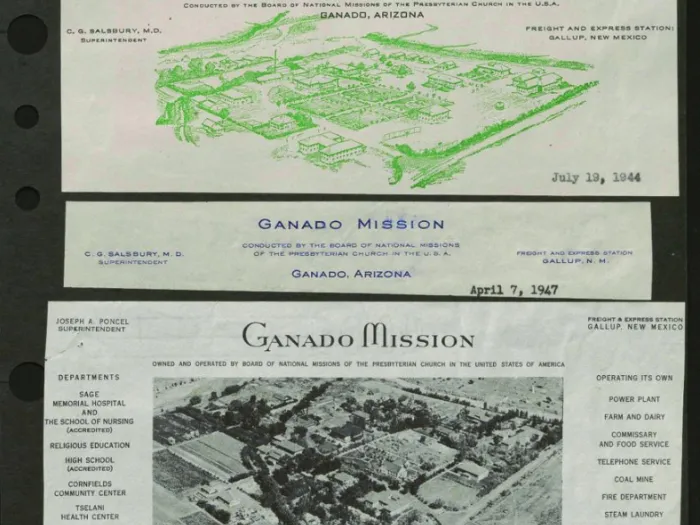In 2023, PHS was awarded a grant from the National Endowment for the Humanities to digitize 22,500 photographs and supporting documents from the Religious News Service Photograph Collection. Work began during the summer months of 2023, and will continue through December 2025. Learn more about the project.
Tucked into cliffsides, carved out of salt, constructed with 10,000 glass panes—where would you like to worship? This month, we are sharing photos of unique and unexpected chapels, discovered within the Presbyterian Historical Society’s Religious News Service Archival Collection. Which of these surprising sanctuaries would you choose for your home church?
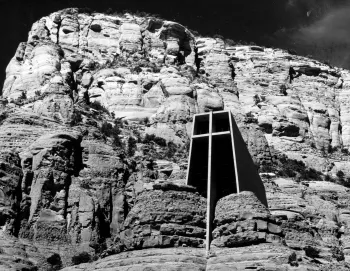
While the Air Force Academy’s ultra-modern sanctuary is gorgeous and vast, this Arizona chapel’s most beautiful feature is its backdrop. The Roman Catholic Chapel of the Holy Cross in Sedona is a favorite of tourists to the state—the church’s website boasts that it is rated #1 of the ten best attractions in the city!
Located in Oak Creek Canyon, within the larger Coconino National Forest, the chapel was constructed from 1954 to 1956. From the caption: “Its altar windows look out on the vast red rock formations which stretch out infinitely through the famous Valley of the Sun.” What a beautiful sight to behold! Can you imagine witnessing a sunrise or sunset from within this sanctuary?
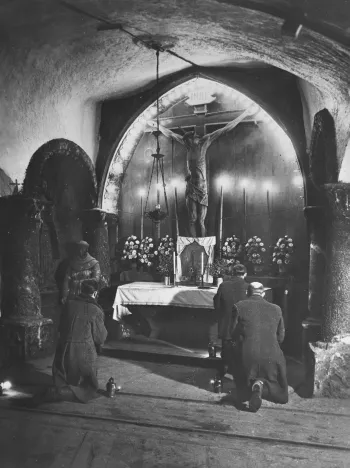
From a chapel amongst the cliffs, to a chapel beneath the earth. The above chapel is one of four carved from salt within the Wieliczka Salt Mine near Kraków, Poland. At its deepest point, the mine reaches 327 meters or 1,073 feet belowground. Its chambers and passageways stretch for over 175 miles—the visitors’ route, a 2.2 mile adventure, makes up less than 2% of the mine’s total length.
First excavated in the 13th century, the mine produced table salt continuously until 1996, when, due to falling prices and frequent mine flooding, commercial mining was discontinued. The mine is an official Polish Historic Monument, as well as a UNESCO World Heritage Site, having been included on the first UNESCO World Heritage List in 1978. Visitors are welcome to wander the labyrinthine passageways, discover the history of salt-mining, witness an underground lake, and enter four chapels that were carved out by miners—including the one that was captured in the image above, where three men kneel in front of an altar tucked into a wall of salt in 1948.
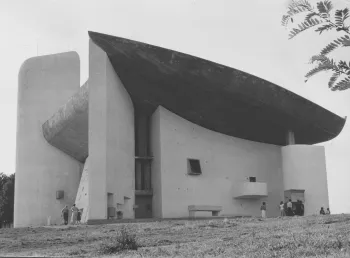
This chapel in Ronchamp, France, is incredibly unique and original—for two reasons. The first is its roof. The second is its singing.
Created by Swiss-French architect and urban planner Le Corbusier, this sanctuary is a stunning piece of modern architecture—of which Le Corbusier is considered a pioneer. Buildings designed by Corbusier can be found in Europe, Japan, India, and North and South America. His career spanned five decades, and in 2016, seventeen of his structures located in seven different countries were included in the UNESCO World Heritage Sites list as “The Architectural Work of Le Corbusier, an Outstanding Contribution to the Modern Movement.” The above chapel in Ronchamp was one of the seventeen examples.
Built in 1955, the chapel was given the title of “Notre-Dame du Haut”—translated, this means “Our Lady of the Heights.” She sits on a French hillside, so the name is rather apt. An active site under the guardianship of a private foundation dedicated to the upkeep and maintenance of the church, Notre-Dame du Haut welcomes over 80,000 guests across its threshold annually.
This is not the first chapel to sit atop this hill, nor to hold the title of “Our Lady of the Heights.” The original chapel that sat on Rochamp’s hill was built in the 13th century. Le Corbusier’s structure was commissioned by the Association de l'Euvre Notre-Dame du Haut after the Second World War, during which the first building had been destroyed.
Not only is its roof sloping and strange—in the caption, it is described as being “shaped like an oriental slipper”—but the chapel’s windows, seen above, are equally striking. Varying in size and ratio, the architectural design makes it so that when the mountain winds dance through the chapel’s archways and duck between the columns, organ-music sounds reverberate and echo for many miles. Hence, it is often called the “singing” chapel.
(Want more? Check out this 30-second clip from the year Le Corbusier’s renovated chapel was opened to the public.)
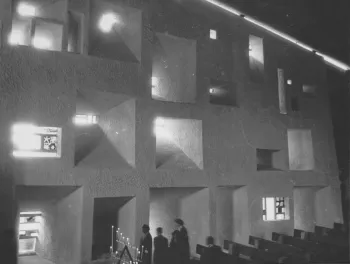
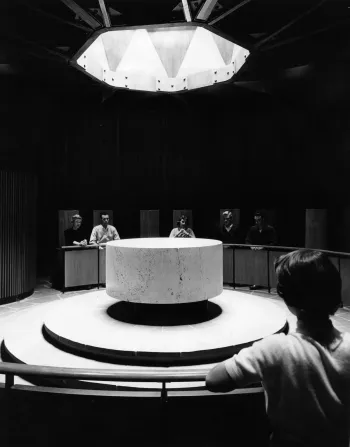
In the image above, taken in 1955, six young adults “meditate around the communion table” of “one of the most unique campus chapels in America”—the Oreon E. Scott Memorial Chapel at Drake University in Des Moines, Iowa.
The chapel, designed as a place of prayer and meditation for students of all faiths, does not feature a pulpit or lecturn. Rather, there is only the massive Roman Travertine stone Communion Table, which sits on a raised podium in the center of the space. The stone’s diameter is four feet. A prayer rail—upon which we see one student leaning—and twenty high-backed chairs—where the five other students sit—surround the table in a circle. The only natural light comes from the large skylight seen above. Other features of the chapel include an electronic organ, radiant heating, and fluorescent lights.
The chapel, as its name suggests, was a gift from one Dr. Oreon E. Scott, a St. Louis realtor and prominent layman among the Disciples of Christ, the religious group with which Drake University was affiliated.
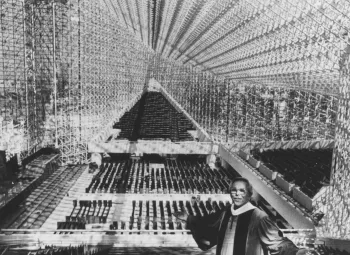
The creation of a “crystal cathedral” sounds like something straight from a fairytale—the Garden Grove Community Church in California turned it into a reality, however, in 1980.
Seen above is the church’s founder-pastor, Protestant Reverend Robert Schuller, standing in the balcony of his congregation’s huge new sanctuary. They’d outgrown the previous building, thanks in part to the Reverend’s “Hour of Power” television show. Schuller hired American architect Philip Johnson, along with his partner John Burgee, to design the new church building—and the Crystal Cathedral was born.
From the caption: “The towering structure, to be opened later this year, has 10,000 panes of tinted glass mounted in a web of steel rods. It will seat 3,000 people and include a 90-foot-high glass door near the pulpit, enabling Dr. Schuller to preach to his audience on the grounds or seated in their cars.” The Crystal Cathedral was one of the first megachurches to be established in the nation, developed and constructed by a man who began preaching at the Orange Drive-In Theater over twenty years before—hence his insistence that his drive-in congregants still be able to access his services.
What was once known as the Crystal Cathedral, one of the largest and most distinctive Protestant churches in the U.S., is now called Christ Cathedral. In 2012, Schuller’s ministry filed for bankruptcy, selling the building and surrounding thirty-four acre campus to the Roman Catholic Diocese of Orange, who now utilize the renovated Christ Cathedral as their headquarters.
--
Which unique church building would you prefer to attend service in? How do these ornate and unexpected chapels compare to your home church’s sanctuary? As you compare and contrast, remember that whether in front of an altar table topped with a fifteen-foot-long slab of marble or at your desk at work, the Spirit of the Lord is happy to join you wherever you are.
--
Check out the Religious News Service Photograph Collection in Pearl
You may freely reuse and distribute this article in its entirety for non-commercial purposes in any medium. Please include author attribution, photography credits, and a link to the original article. This work is licensed under a Creative Commons Attribution-NonCommercial-NoDeratives 4.0 International License.




